This week Microsoft announced the preview support of Microsoft Azure SQL Edge on Red Hat Enterprise Linux (RHEL) 8. With Azure SQL Edge, developers can now more easily extend their existing SQL Server 2019 offerings for RHEL and Red Hat Openshift to IoT edge gateways and devices for consistent edge to cloud data management.
What is Azure SQL Edge?
Azure SQL Edge is a small-footprint database delivered as an Open Containers Initiative (OCI) compatible container for connected, disconnected or hybrid environments and supports the latest generation of the Podman container management tools on RHEL 8. Features include built-in data streaming and time series, with in-database machine learning and graph features for low-latency analytics as well as capabilities for machine learning at the edge to optimize bandwidth, reaction time, and cost.
Because Azure SQL Edge is packaged as a container, it is easy to deploy and update on RHEL. You can pull the latest image down from an internal repository directly to your edge devices, from the official MIcrosoft container repository, or manage everything directly from Microsoft Azure. A basic installation for an Azure SQL Edge developer edition on RHEL is as simple as running:
$ podman run --cap-add SYS_PTRACE -e 'ACCEPT_EULA=1' -e 'MSSQL_SA_PASSWORD=StrongPassword' -p 1433:1433 --name azuresqledge -d mcr.microsoft.com/azure-sql-edge
That’s it! The Azure SQL Edge database is up and running and you're ready to start developing your RHEL-based project on the edge.
 Do you know about Red Hat Enterprise Linux's latest features and updates?
Do you know about Red Hat Enterprise Linux's latest features and updates?
 Do you know about Red Hat Enterprise Linux's latest features and updates?
Do you know about Red Hat Enterprise Linux's latest features and updates?
Why Choose Red Hat Enterprise Linux for Azure SQL Edge Deployments?

Choosing RHEL as the platform for Azure SQL Edge addresses a broad range of enterprise use cases across industries. RHEL is the leading Linux platform and offers built-in edge capabilities on small footprints ranging from high performance systems - such as carrier grade systems with latency sensitive workloads - to scaling across remote sites on lightweight hardware with limited or unreliable connectivity. RHEL handles workloads requiring long-term stability, supportability, and enhanced security across a broad hardware ecosystem—ensuring delivery of services quickly and consistently across the datacenter to IoT edge devices and gateways. By running Azure SQL Edge on RHEL you can reduce operational costs by gaining stability and interoperability with existing core systems. This allows you to maximize the value of in-house skills and focus on the business impact of your data and workloads.
The availability of Azure SQL Edge on RHEL expands the existing ecosystem of tools, applications, frameworks, and libraries for building and running containers on the edge with a platform that is already a huge success in the enterprise. And since Azure SQL Edge is built with the same core engine as SQL Server, it can take full advantage of the enhancements we’ve made to RHEL for a widely used commercial database including the mssql tuned profile and the Performance Co-pilot Performance Metrics Domain Agent (PMDA) for SQL Server.
With Azure SQL Edge on RHEL 8.3, IT architects can take advantage of the latest enhancements to help administrators and organizations cope with the challenges of edge computing by simplifying image creation, reducing update sizes, and fending off unnecessary downtime. These enhancements include the ability to rapidly generate customized operating system images for the edge, capabilities that allow the delivery of efficient over-the-air (OTA) updates, and intelligent rollback capabilities to avoid downtime.
You can learn more about Red Hat’s strategy for edge computing here.
Sobre el autor
Louis Imershein is a Product Manager at Red Hat focussed on Microsoft SQL Server and database workloads. He is responsible for working with Microsoft and Red Hat engineering to ensure that SQL Server performance, management, and security is optimized for Red Hat platforms. For more than 30 years, Louis has worked in technical support, engineering, software architecture, and product management on a wide range of OS, management, security, and storage software projects. Louis joined Red Hat as part of the acquisition of Permabit Technology Corporation, where he was VP of Product.
Navegar por canal
Automatización
Conozca lo último en la plataforma de automatización que abarca tecnología, equipos y entornos
Inteligencia artificial
Descubra las actualizaciones en las plataformas que permiten a los clientes ejecutar cargas de trabajo de inteligecia artificial en cualquier lugar
Servicios de nube
Conozca más sobre nuestra cartera de servicios gestionados en la nube
Seguridad
Vea las últimas novedades sobre cómo reducimos los riesgos en entornos y tecnologías
Edge computing
Conozca las actualizaciones en las plataformas que simplifican las operaciones en el edge
Infraestructura
Vea las últimas novedades sobre la plataforma Linux empresarial líder en el mundo
Aplicaciones
Conozca nuestras soluciones para abordar los desafíos más complejos de las aplicaciones
Programas originales
Vea historias divertidas de creadores y líderes en tecnología empresarial
Productos
- Red Hat Enterprise Linux
- Red Hat OpenShift
- Red Hat Ansible Automation Platform
- Servicios de nube
- Ver todos los productos
Herramientas
- Training y Certificación
- Mi cuenta
- Recursos para desarrolladores
- Soporte al cliente
- Calculador de valor Red Hat
- Red Hat Ecosystem Catalog
- Busque un partner
Realice pruebas, compras y ventas
Comunicarse
- Comuníquese con la oficina de ventas
- Comuníquese con el servicio al cliente
- Comuníquese con Red Hat Training
- Redes sociales
Acerca de Red Hat
Somos el proveedor líder a nivel mundial de soluciones empresariales de código abierto, incluyendo Linux, cloud, contenedores y Kubernetes. Ofrecemos soluciones reforzadas, las cuales permiten que las empresas trabajen en distintas plataformas y entornos con facilidad, desde el centro de datos principal hasta el extremo de la red.
Seleccionar idioma
Red Hat legal and privacy links
- Acerca de Red Hat
- Oportunidades de empleo
- Eventos
- Sedes
- Póngase en contacto con Red Hat
- Blog de Red Hat
- Diversidad, igualdad e inclusión
- Cool Stuff Store
- Red Hat Summit

